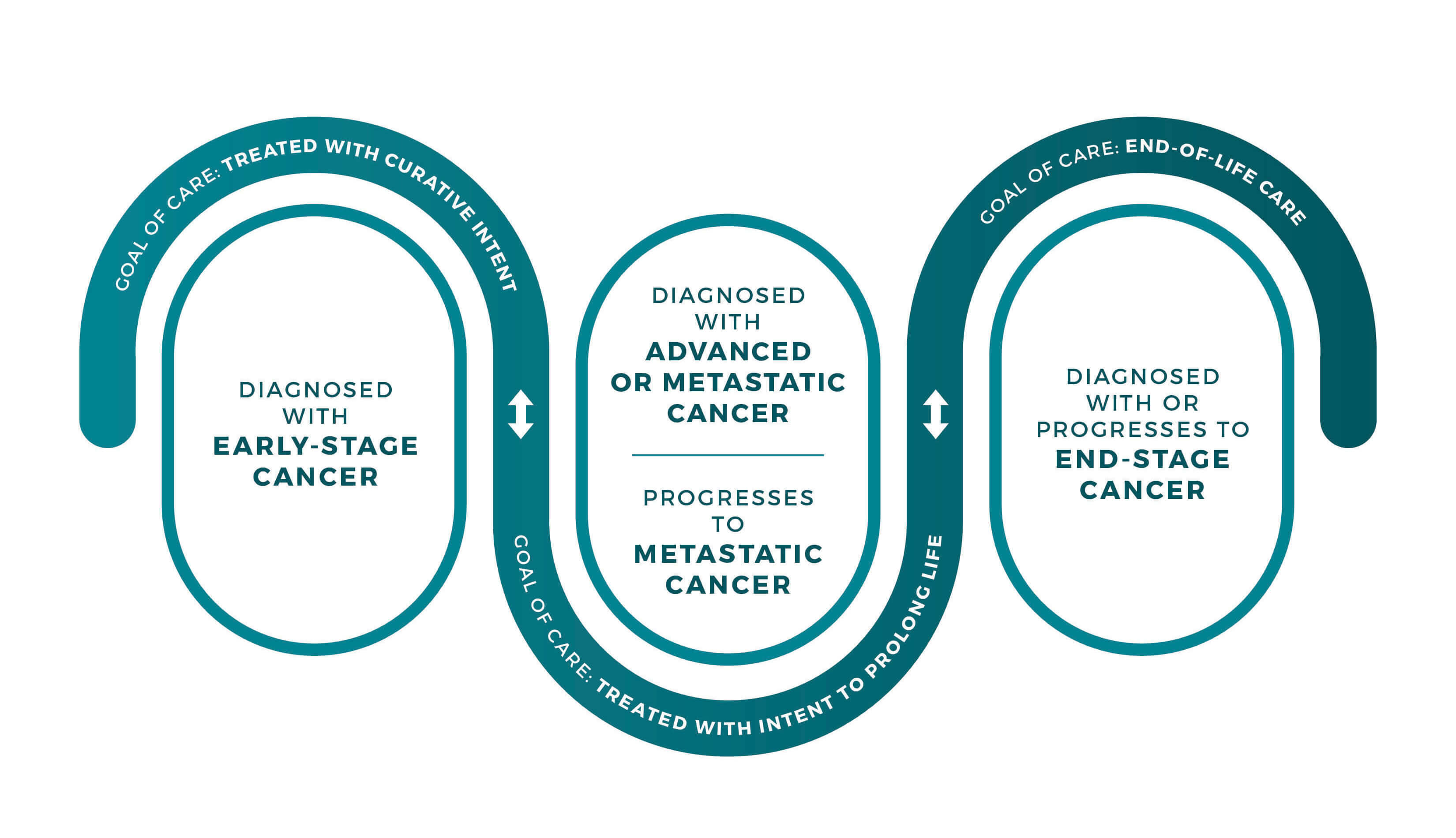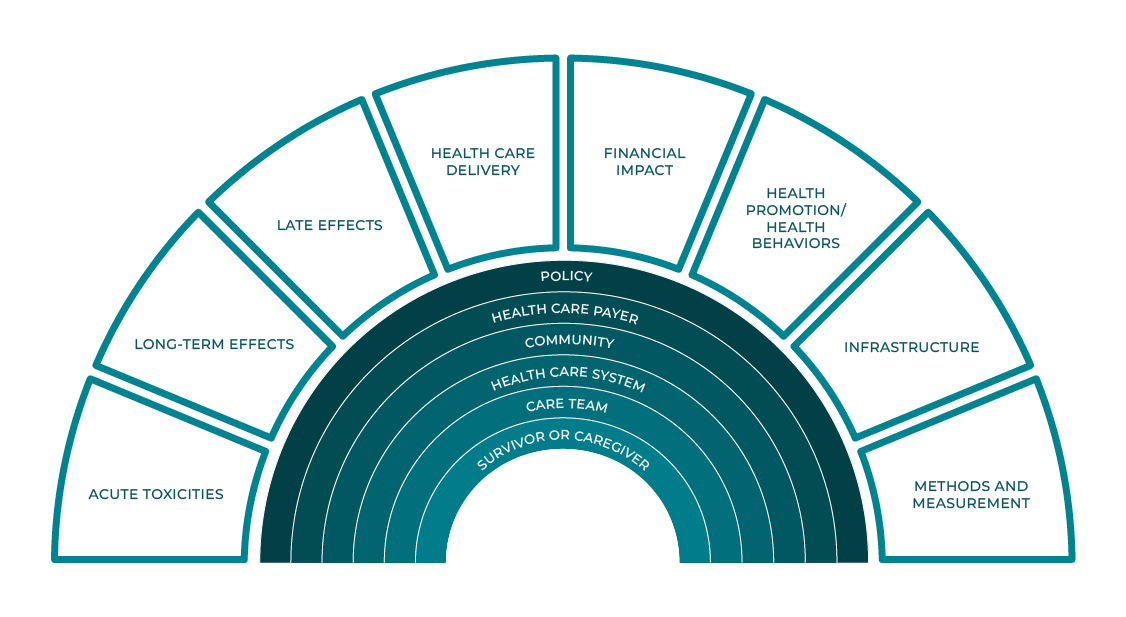Who is a cancer survivor? Years ago, some suggested that the definition should only include people who were cancer-free for a minimum amount of time after their diagnosis. NCI's definition begins at the time of diagnosis. Below, find the definition of cancer survivor, as well as other survivorship-related and statistical terms.
On This Page
Survivorship Terms
Cancer Survivor
An individual is considered a cancer survivor from the time of diagnosis through the balance of life. There are many types of survivors, including those living with cancer and those free of cancer. This term is meant to capture a population of those with a history of cancer rather than to provide a label that may or may not resonate with individuals.

Cancer Survivorship
Cancer survivorship is a state of being, including the perspectives, needs, health, and the physical, psychological, social, and economic challenges experienced by people and caregivers after a cancer diagnosis.

Phases of Cancer Survivorship
There is no one face or kind of cancer survivor. Some have been treated for their cancer and remain cancer-free, while others continue to live with cancer. The experiences and goals of care for each cancer survivor are unique and dynamic. The figure below depicts one way to think about the different types of cancer survivors, including those diagnosed with early-stage cancer or advanced cancer and those who are diagnosed with or progress to end-stage cancers.

Cancer Survivorship Care
Cancer survivorship care is comprehensive care for all people who have a history of cancer. It begins at the time of diagnosis, has the goal of assessing and mitigating the impact of cancer and its treatment, and includes the following components of care:
- Surveillance and amelioration of physical, emotional, and psychological effects, including evaluation of risk, prevention, and management of late effects
- Surveillance for recurrence and new cancers
- Assessment and promotion of health behaviors (e.g., smoking cessation, physical activity)
- Coordination of care between care team members, health systems, survivors, and caregivers
- Addressing comorbidities and preventing and managing chronic conditions exacerbated by cancer and its treatment
- Engagement in care planning, including discussing goals of care and advanced care planning
- Provision of supportive health services (e.g., nutrition, occupational and physical therapy, rehabilitation, sexual health, fertility services, dental and podiatry services)
- Genetic risk assessment or referral to genetic testing as appropriate
- Management of social risks, health-related social needs, education and employment
- Addressing financial hardship and insurance coverage

Cancer Survivorship Care, graphic created by the National Cancer Institute
and adapted from the National Standards for Cancer Survivorship Care
Cancer Survivorship Research
Cancer survivorship research seeks to enhance the health and well-being of all cancer survivors and caregivers. This research aims to prevent and mitigate acute and late-occurring physical, psychological, social, and economic effects of cancer and its treatment, improve care delivery, promote healthy behaviors, develop and sustain research infrastructure, and improve research methodologies for individuals impacted by cancer.

Cancer Survivorship Research, graphic created by the National Cancer Institute
- Acute physiological or psychosocial toxicities: symptoms or side effects that can occur during or immediately following cancer treatment
- Long-term effects of cancer and its treatment: physiological and psychosocial issues that can last months or years after cancer treatment has ended
- Late effects of cancer and its treatment: physiological and psychosocial issues that occur months to years after receiving a treatment (including recurrence and subsequent malignancies)
- Health care delivery: cancer care, factors influencing care, and outcomes of care
- Financial impact and cancer health economics: factors associated with the organization, production, delivery and demand for cancer-related care, as well as outcomes such as type, quantity, quality, and cost of care faced by the patient, family, payer, and society
- Health promotion/Health behaviors: encouraging or supporting healthy behaviors for cancer patients, survivors, and caregivers. Examples include physical activity, nutrition, prevention, sleep, vaccination, and avoiding risky behaviors (e.g., smoking, alcohol use)
- Infrastructure: organizational, health system, and other elements necessary to build research resources, including cohorts, registries, and biobanking repositories
- Methods and measurements: improving and developing methodology for cancer survivors and caregivers through innovations in research design, measurement, data collection and data analysis techniques
The Cancer Continuum
The cancer control continuum is a useful framework on which to view plans, progress, and priorities. It helps us identify research gaps, where we must collaborate with others to have an impact, and where more resources may be needed. This updated figure reflects the non-linear nature of the continuum.

The Cancer Continuum, graphic created by the National Cancer Institute
Statistical Terms
- Cancer Incidence
- The cancer incidence rate is the number of new cancers of a specific site/type occurring in a specified population during a year, usually expressed as the number of cancers per 100,000 population at risk.
- Cancer Prevalence
- Cancer prevalence is the number of people alive on a certain date who have been diagnosed with cancer. This includes individuals who are newly diagnosed, in active treatment, have completed active treatment, and those living with progressive symptoms of their disease. Prevalence is derived from long-term incidence and survival rates.
- Limited Duration Prevalence
- Limited duration prevalence represents the proportion of people alive on a certain day who had a diagnosis of the disease within the past x years (e.g. x = 5, 10, 20, or 25 years).
- Observed Survival Rate
- The observed survival rate, which is obtained using standard life table procedures, represents the proportion of cancer patients surviving for a specified length of time after diagnosis.
For other cancer terms, see the NCI Dictionary of Cancer Terms.
Mollica MA, Tesauro G, Tonorezos ES, Jacobsen PB, Smith AW, Gallicchio L. (2021) Current state of funded National Institutes of Health grants focused on individuals living with advanced and metastatic cancers: a portfolio analysis. J Cancer Surviv.15:370–374.
Mullan F (1985). Seasons of survival: reflection of a physician with cancer. N Engl J Med;313:270–273.
Mollica, M.A., McWhirter, G., Tonorezos, E. et al. Developing national cancer survivorship standards to inform quality of care in the United States using a consensus approach. J Cancer Surviv 18, 1190–1199 (2024).

